Friday, July 28th 2017

AMD Ryzen Threadripper Delidded - It's EPYC
Overclocker extraordinaire der8auer, who was one of the most vocal enthusiasts calling out for better VRM designs on Intel's X299 platform (and who worked with ASUS on redesigning the VRM cooling in its motherboards) has gone and done it: he delidded a Ryzen Threadripper CPU. And this delidding went on to deliver the goods: Ryzen Threadripper delidded is EPYC (pun intended.)
Instead of the expected MCM composed of two dies (with two CCXs of four cores per die, delivering the 16 cores we were expecting), Ryzen Threadripper is actually a much more interesting chip: it seems to be a full fledged EPYC chip, with four dies of eight cores. According to der8auer, when questioned, AMD confirmed that 16-core Threadripper 1950X CPUs are configured with two working eight core dies (four CCXs of four cores each), while the other eight-core dies are disabled by AMD.A very, very interesting question here is whether these are actually defective or just disabled by AMD, which is something the company is naturally mum about. With AMD's history of core unlocking, and the fact that Zen-based CPUs have high yields, we can certainly hope (maybe even expect) that not all disabled cores are non-functional, and that AMD had to disable some of them so as to achieve their SKU core-count. Whether or not those will be unlockable, though, is anybody's guess. Der8auer also found that AMD Threadripper dies are gold plated on the inside, so as to improve conditions and adherence of the indium solder AMD used (some users might say that while Intel uses cheap TIM on their HEDT, X299 CPUs, AMD even sells these with gold inside.) This fact naturally also opens the question of future platform scalability - AMD can certainly decide to just up available maximum core-count on their Threadripper line of CPUs (we still have at least 4 model numbers above the 1950X, an potentially more.)Check Der8auer's delidding video on YouTube below.
Source:
Der8auer's YouTube Channel
Instead of the expected MCM composed of two dies (with two CCXs of four cores per die, delivering the 16 cores we were expecting), Ryzen Threadripper is actually a much more interesting chip: it seems to be a full fledged EPYC chip, with four dies of eight cores. According to der8auer, when questioned, AMD confirmed that 16-core Threadripper 1950X CPUs are configured with two working eight core dies (four CCXs of four cores each), while the other eight-core dies are disabled by AMD.A very, very interesting question here is whether these are actually defective or just disabled by AMD, which is something the company is naturally mum about. With AMD's history of core unlocking, and the fact that Zen-based CPUs have high yields, we can certainly hope (maybe even expect) that not all disabled cores are non-functional, and that AMD had to disable some of them so as to achieve their SKU core-count. Whether or not those will be unlockable, though, is anybody's guess. Der8auer also found that AMD Threadripper dies are gold plated on the inside, so as to improve conditions and adherence of the indium solder AMD used (some users might say that while Intel uses cheap TIM on their HEDT, X299 CPUs, AMD even sells these with gold inside.) This fact naturally also opens the question of future platform scalability - AMD can certainly decide to just up available maximum core-count on their Threadripper line of CPUs (we still have at least 4 model numbers above the 1950X, an potentially more.)Check Der8auer's delidding video on YouTube below.
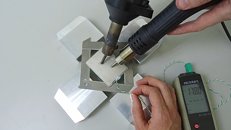

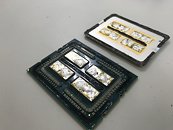

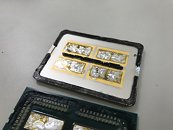
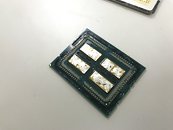
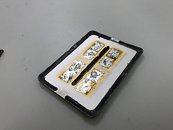
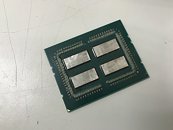
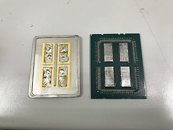
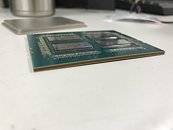
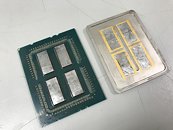
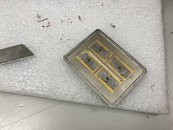
55 Comments on AMD Ryzen Threadripper Delidded - It's EPYC
Intel have been using same uarch across all market segmentation, yes
but they need to create brand new silicon to be able address market demand
you dont just take Xeon 12 core cpu and disable it, sold as G4560
So much for unlocking cores...:(
They would use a shim over that or dead chips.
The NRE cost of chips is the big expense.
On the Threadripper I agree I wouldn't be too concerned about aging. Since it's got quality solder you don't have to worry about delidding (which shouldn't be necessary if Intel would use decent compound themselves), and it will be obsolete before needing replaced. If I get 4 or 5 overclocked years out of a CPU I'm happy and relegate it to live out it's days in a secondary PC.
You'd probably never do it and I certainly won't, but apparently there's enough people that do it out there, that this exists: rockitcool.myshopify.com/
Anyway, it's awesome to see under the heatspreader anyway, so while I may not approve of de8hauer at all times, I still gotta say thanks. :pEvery single one of mine, and there are a few members on here that do the LN2 stuff as well as air/water and all that too. Guys like macci and K1ngp1n drew me deep into hardware, and that led to me doing reviews. I just don't post anything about my LN2 adventures, because I'm not a competitive person. It's more about seeing how these CPUs work, and since I do tend to get quite a few free CPUs, I'm not going to have any losses from doing so. I mean, a decade ago there were many many of us buying $300 CPUs/GPUs every two weeks with our pay cheques and clocking the crap out of them. It was loads of fun. Then HWBot came, people went into teams, and that whole world became quite closed and elitist.
Edit: Now that I think of it, it was either Celeron or Pentium back then, or K6 series.... And I remember the prices on even the Celerons being too high--for me anyways.